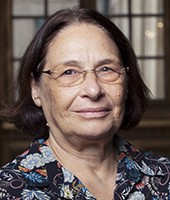Tamar Flash
Tamar Flash is an Emeritus professor at the Department of Computer Science and Applied Mathematics, Weizmann Institute of Science, Israel. She received BSc and MSc degrees in Physics from Tel-Aviv University and her Ph.D. degree in Medical Physics from MIT, Cambridge, MA. Together with her students and colleagues, she focuses on research in computational neuroscience, human motor control, movement disorders, and on motion control in biological (e.g., octopus) and soft robotic systems.
In October 2023, she joins the IAS for a one-month writing residency.
Research Interests
Human and biological motor control, Trajectory planning, Optimal control of movement, Space-time representation of movement in the brain and Arts, Movement disorders, Humanoid Robots, Biomechanics and control of muscle hydrostats, Soft Robotics
Space-time geometries and scaling principles subserving brain production and perception of movement
This project aims to furtherly extend earlier modeling studies based on symmetry theory and space-time geometries to unravel the relationship between movement production and perception by the brain, and neural encoding and brain organization. Recent progress involved work aimed at associating precise mathematical models of motor control and motion perception with neural encoding by single cells and neural populations. Hence, the current project aims to demonstrate how differential geometry and optimization theories can help to investigate the decoding of neuronal activities in several brain areas to explore plausible functional roles of these areas (i.e. the Basal Ganglia, and Motor Cortex). Such studies may enable us to obtain a better understanding of how recorded neuronal activities may give rise to the spatial and temporal invariants and compositional principles observed during the generation of both motion elements and sequential movements and to the perception of speed and time during motion perception. Another aim is to explore how theories and tools developed in Physics and biology to account for scale-free invariance in natural phenomena can apply to brain mechanisms subserving motion action and perception. This work may have wide implications for advancing our understanding of motor learning and development, movement disorders, social interactions, and movement generation and perception in different artistic modalities.
Key publications
Flash, T. and Hogan, N., 1985. The coordination of arm movements: an experimentally confirmed mathematical model. Journal of Neuroscience, 5(7), pp.1688-1703.
Bennequin, D., Fuchs, R., Berthoz, A. and Flash, T., 2009. Movement timing and invariance arise from several geometries. PLoS computational biology, 5(7), p.e 1000426.
Flash, T. and Berthoz, A. eds., 2021. Space-time geometries for motion and perception in the brain and the arts. Springer Nature.
|
Fourth session of the "Paris IAS Ideas" talk series, with the participation of Tamar Flash, Weizmann Institute of Science, Israel |
|
|
|
|

